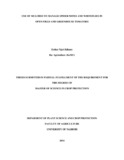| dc.description.abstract | Tomato (Lycopersium esculentum) is one of the widely consumed vegetables in Kenya grown
by both small holders and large commercial producers .A study consisting of a survey and field
experiment was undertaken in Laikipia County to determine the occurrence, severity of spider
mites and whiteflies infestation, and the farmer’s management practices. The survey included 79
farmers, where 49 were open field tomato farmers while 30 were greenhouse tomato farmers.
Simple random sampling technique was used to collect information on the occurrence and
severity of spider mites and whiteflies on tomatoes, the farmers management practices, and the
control measures applied by the tomato farmers in Laikipia County. Field experiments were
carried out over two growing seasons at Nanyuki children’s home in Laikipia County between
August 2012 and June 2013. Experiments were conducted both inside the greenhouse and in the
open field. Five treatments were administered as follows: Reflective mulch, no mulch, wheat
straw mulch, black mulch, and chemical control. Chemical was applied as a positive control and
no mulch plot provided negative control
The survey results indicated that majority (90%) of the respondents in the open field had
spider mites infestation in their tomato crops, while 63% in greenhouse had similar problem.
All the respondents (100%) in the greenhouse and open field had whiteflies infestation on
their tomato farms. About 80 % of the open field production system had a high to very high
infestation level (51-100%) of mites and whiteflies while in the greenhouse production system
majority of the respondents (42% and 30%) reported low infestation level of 0-25% of mites and
whiteflies respectively. A total of 79% of the greenhouse farmers who were interviewed had low
to medium infestation level (0-50%) of mites and whiteflies, respectively.
midland 5 by 67% and 57% of the respondents respectively. High infestation level was noted in
the Agro-ecological zone lower highland 4 (LH4) with a severity of 68% for spider mites and
60% for whiteflies. Similarly, medium infestation of 26-50% was noted at lower highland 5
(LH5) for the spider mites at 66.7% and 63.5% for whiteflies. The severity of infestation by
spider mites was low in the UH2 and no respondent was noted with medium to high infestation
26-100%.
Chemical control was the most effective method for mites and whiteflies control in the open field
and greenhouse tomato production systems .However, the three mulches reduced the number of
mites and white flies on the tomatoes compared to the control. The mean number of mites over
six weeks period was highest in the green house as compared to the open field production during
both seasons. In the present study the mite numbers in the green house, when compared with the
control were reduced by 37%, 51% and 44% by black, wheat straw and white mulch
respectively. In the open field the numbers of mites were reduced as follows; 10.8%, 25%, 37%
by black, wheat straw and white mulch respectively. The whiteflies numbers in the green house,
when compared with the control were reduced by 27%, 48% and 45% by black, wheat straw and
white mulch respectively. In the open field the numbers of whiteflies were reduced as follows;
37%, 51% and 64% by black, wheat straw and white mulch respectively. Among the three
mulches the white mulch worked better in the control of mites and whiteflies in the open field
than in the greenhouse environment. The wheat straw mulch reduced the pests population best in
the greenhouse environment. | en_US |

